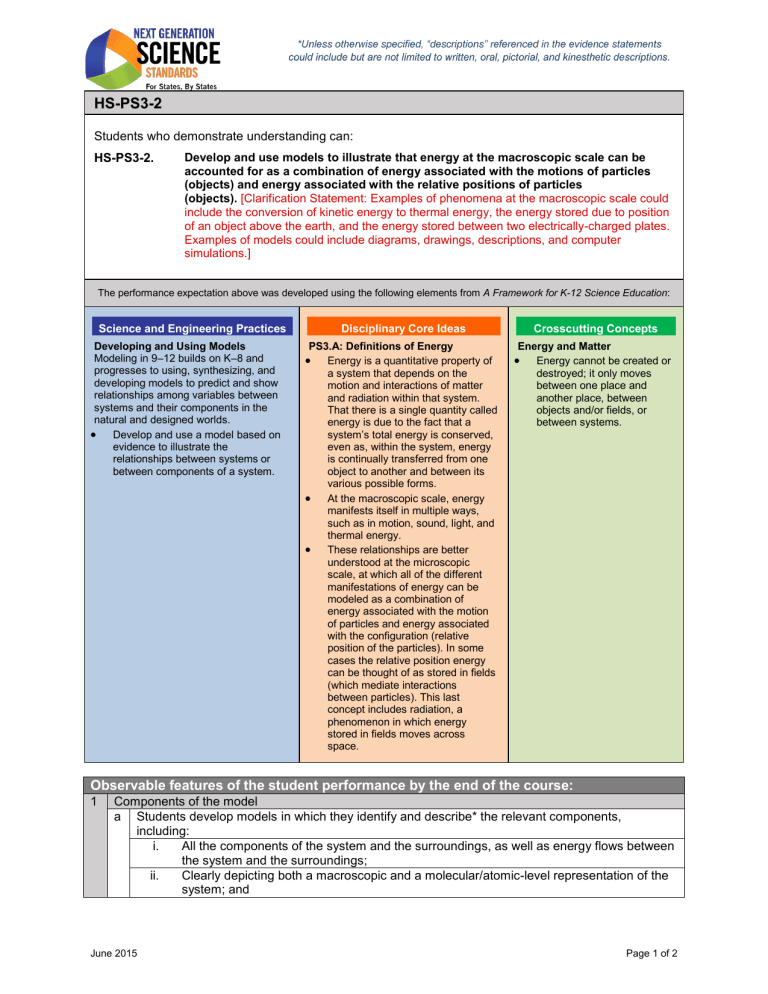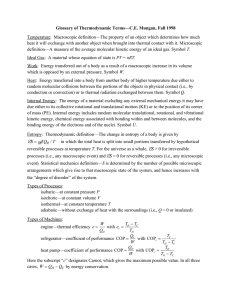
HS-PS3-2 Students who demonstrate understanding can: HS-PS3-2. Develop and use models to illustrate that energy at the macroscopic scale can be accounted for as a combination of energy associated with the motions of particles (objects) and energy associated with the relative positions of particles (objects). [Clarification Statement: Examples of phenomena at the macroscopic scale could include the conversion of kinetic energy to thermal energy, the energy stored due to position of an object above the earth, and the energy stored between two electrically-charged plates. Examples of models could include diagrams, drawings, descriptions, and computer simulations.] The performance expectation above was developed using the following elements from A Framework for K-12 Science Education: Science and Engineering Practices Developing and Using Models Modeling in 9–12 builds on K–8 and progresses to using, synthesizing, and developing models to predict and show relationships among variables between systems and their components in the natural and designed worlds. Develop and use a model based on evidence to illustrate the relationships between systems or between components of a system. Disciplinary Core Ideas PS3.A: Definitions of Energy Energy is a quantitative property of a system that depends on the motion and interactions of matter and radiation within that system. That there is a single quantity called energy is due to the fact that a system’s total energy is conserved, even as, within the system, energy is continually transferred from one object to another and between its various possible forms. At the macroscopic scale, energy manifests itself in multiple ways, such as in motion, sound, light, and thermal energy. These relationships are better understood at the microscopic scale, at which all of the different manifestations of energy can be modeled as a combination of energy associated with the motion of particles and energy associated with the configuration (relative position of the particles). In some cases the relative position energy can be thought of as stored in fields (which mediate interactions between particles). This last concept includes radiation, a phenomenon in which energy stored in fields moves across space. Crosscutting Concepts Energy and Matter Energy cannot be created or destroyed; it only moves between one place and another place, between objects and/or fields, or between systems. Observable features of the student performance by the end of the course: 1 Components of the model a Students develop models in which they identify and describe* the relevant components, including: i. All the components of the system and the surroundings, as well as energy flows between the system and the surroundings; ii. Clearly depicting both a macroscopic and a molecular/atomic-level representation of the system; and June 2015 Page 1 of 2 iii. 2 3 Depicting the forms in which energy is manifested at two different scales: a) Macroscopic , such as motion, sound, light, thermal energy, potential energy or energy in fields; and b) Molecular/atomic, such as motions (kinetic energy) of particles (e.g., nuclei and electrons), the relative positions of particles in fields (potential energy), and energy in fields. Relationships a Students describe* the relationships between components in their models, including: i. Changes in the relative position of objects in gravitational, magnetic or electrostatic fields can affect the energy of the fields (e.g., charged objects moving away from each other change the field energy). ii. Thermal energy includes both the kinetic and potential energy of particle vibrations in solids or molecules and the kinetic energy of freely moving particles (e.g., inert gas atoms, molecules) in liquids and gases. iii. The total energy of the system and surroundings is conserved at a macroscopic and molecular/atomic level. iv. Chemical energy can be considered in terms of systems of nuclei and electrons in electrostatic fields (bonds). v. As one form of energy increases, others must decrease by the same amount as energy is transferred among and between objects and fields. Connections a Students use their models to show that in closed systems the energy is conserved on both the macroscopic and molecular/atomic scales so that as one form of energy changes, the total system energy remains constant, as evidenced by the other forms of energy changing by the same amount or changes only by the amount of energy that is transferred into or out of the system. b Students use their models to illustrate that energy at the macroscopic scale can be accounted for as a combination of energy associated with the motions of particles/objects and energy associated with the relative positions of particles/objects on both the macroscopic and microscopic scales. June 2015 Page 2 of 2



